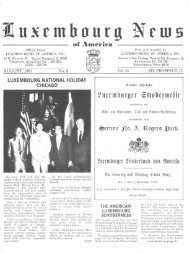$150.00 - Luxembourg American Heritage Information Center
$150.00 - Luxembourg American Heritage Information Center
$150.00 - Luxembourg American Heritage Information Center
You also want an ePaper? Increase the reach of your titles
YUMPU automatically turns print PDFs into web optimized ePapers that Google loves.
John Keil — Grand Trustee<br />
George J. Meyers, Jr.<br />
Grand Lodge Historian<br />
The second day of festivities for the Royal Family<br />
started with a tour of several cultural centers. After an early<br />
visit to City Hall, where the Grand Duke was presented<br />
with a key to the city by His Honor, Mayor Washington,<br />
the City Council proclaimed the day as "<strong>Luxembourg</strong><br />
Day" in Chicago.<br />
From City Hall the visitors were taken to the new Art<br />
Institute building on Columbus Drive, where they were<br />
given a guided tour of the "New Impressionist Art Exhibit."<br />
It was here that the Grand Duke was pleased to see the<br />
painting, "The Beach at Cabassan," by Henri Edward<br />
Cross, which portrayed the location of the Ducal summer<br />
home in France.<br />
After viewing the art exhibit, the party was escorted to<br />
the refurbished Trading Room of the Chicago Stock<br />
Exchange where they were served a delightful luncheon,<br />
hosted by Mayor Washington and members of the Chicago<br />
City Council. The Honorable Phillip Rock acted as Master<br />
of Ceremonies.<br />
The next stop was the Field Museum where they<br />
viewed an <strong>American</strong> Indian Exhibit. The museum presented<br />
the Grand Duke with a hand-carved totem pole as a gift.<br />
As a grand finale, Grand Duke Jean and his party traveled<br />
to the Museum of Science & Industry. It was here that they<br />
opened the month long exhibit of "<strong>Luxembourg</strong> Immigration<br />
to the United States." During his tour, the Grand<br />
Duke saw a picture of his mother, Grand Duchess Charlotte,<br />
riding in a motorcade with the late Mayor Richard J.<br />
Daley during her state visit in 1963.<br />
The month long exhibit portrayed in photos and news<br />
stories the immigration of <strong>Luxembourg</strong>ers to America dur-<br />
ing the past 100 years. A complete story about the Royal visit appeared in the December,<br />
1984 issue of the <strong>Luxembourg</strong> News of America, which is reprinted here:<br />
LUXEMBOURG IMMIGRATION EXHIBIT<br />
AT SCIENCE & INDUSTRY MUSEUM<br />
The Grand Lodge was instrumental in getting the <strong>Luxembourg</strong> Immigration<br />
Exhibit at the Science & Industry Museum during the Month of December, 1984. The<br />
exhibit was prepared by the <strong>Luxembourg</strong> National Library. The material was well<br />
researched and covered many facets on immigration to America during the past 100-150<br />
years.<br />
The first wave of immigrants came to America during 1828 and 1840. These people<br />
settled in Western New York and Ohio. The next group came between 1840 and 1860 and<br />
settled in Chicago, Eastern Wisconsin, the Mississippi Valley, Eastern Iowa, Dubuque<br />
and St. Donatus, Iowa. The group from 1880 to 1900 moved further west to Northern<br />
and Southern Minnesota, the Dakotas and Eastern Iowa.<br />
During the 19th Century <strong>Luxembourg</strong> yielded no fewer than one out of every five<br />
immigrants to U.S.A. In the 50 years from 1841 to 1891, population increased from<br />
175,000 to 213,000 in <strong>Luxembourg</strong>. Some 72,000 <strong>Luxembourg</strong>ers immigrated during the<br />
50 year period, mostly to Paris and United States.<br />
1860-1870 5,000 came to America<br />
1870-1880 8,000 came to America<br />
1880-1890 8,000 came to America<br />
1890-1900 6,000 came to America<br />
48





